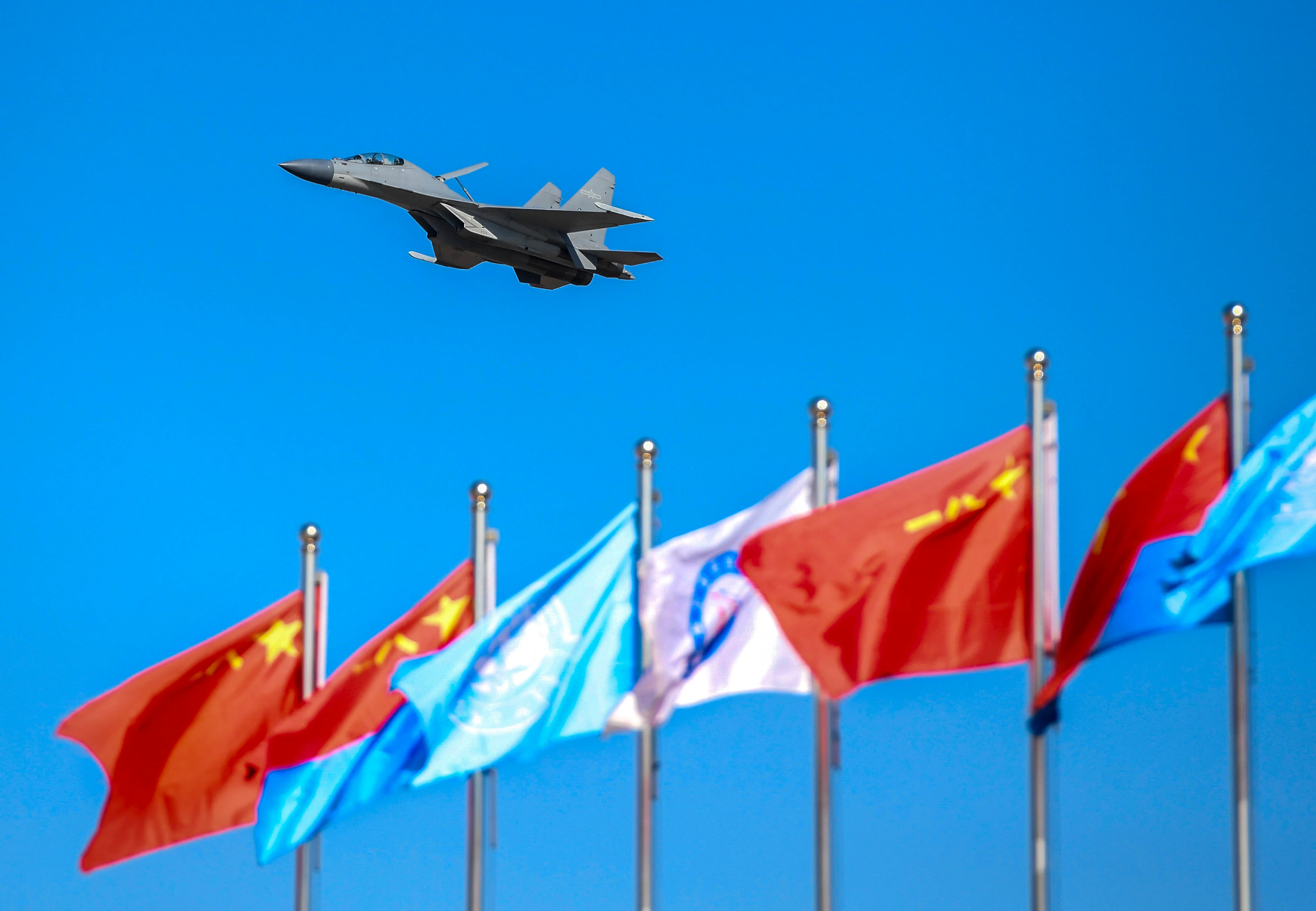Copyright scmp

While the world’s air forces are racing to build sixth-generation stealth fighters, it was an older model that made the headlines earlier this month. A Chinese J-16, a 4.5-generation multirole fighter, was reported by state media to have intercepted two unidentified foreign warplanes near China’s east coast and to have performed a barrel roll over one of the planes. Reports said it may have got as close as 10 metres (33 feet) to the other plane during the manoeuvre last year, which was only reported this month. The J-16 has been overshadowed in recent years by the fifth-generation J-20 but the older plane, nicknamed the Hidden Dragon, has previously featured in encounters with Australian and US reconnaissance planes that prompted complaints from both countries about dangerous manoeuvres. The jet has been in service for almost a decade and regularly patrols along the country’s east coast and potential flashpoints such as the South China Sea and Taiwan Strait. In the event of conflict in the latter area, it is credited by some analysts as forming the “strongest door-kicking combination” in tandem with the J-20. Inside China, the two-seat multirole strike fighter is often described as an “airborne missile truck” – a nod to its impressive payload capacity. Chinese sources say it can carry up to 12 tonnes of ordnance. As well as guided bombs and rockets, it can be equipped with a range of missiles to strike targets on land, sea and air, including the PL-17 which has a reported range of up to 400km (250 miles). The plane has its roots in Russian Sukhoi designs but has been heavily reworked with Chinese avionics, sensors and weapons. Back in the 1990s, Shenyang Aircraft Corporation acquired an Su-27 assembly line and components from Russia and started producing the plane’s forerunner, the J-11. Its evolution reflects a wider shift in Chinese air power doctrine – from a force oriented mainly towards homeland air defence to one that can also go on the offensive and carry out long-range strikes. The first J-16 flight was reportedly in 2011 and it was publicly unveiled in 2013. Its two-seat set-up sees the front pilot flying the aircraft while the rear crew member manages weapons systems and sensors. It is powered by twin Chinese WS-10 engines, which media reports say give it a top speed in excess of Mach 2 and an operational range of over 1,500km. Other features include advanced radar and fire control systems, including an active electronically scanned array radar with a reported range of 200-250km for fighter-sized targets and the ability to track 15–20 targets in the air simultaneously, according to the EurAsian Times. It also has an infrared search and track system, which detects targets from their heat map, with a range of up to 80km. Military Watch Magazine compared the relative merits of the J-16 and the US’ F-15EX – another multirole fighter – and concluded that the J-16 had access to much newer missile types and more powerful engines, as well as a much longer range and superior manoeuvrability. Since entering service, the J-16’s avionics have been steadily upgraded, with the J-16D, a dedicated electronic-warfare variant designed to broaden the People’s Liberation Army’s overall combat abilities, being publicly unveiled in 2021. Earlier this month state broadcaster CCTV reported that the fighter had now been adapted so that it could carry external fuel tanks for the first time – extending its range further. With advances in technology, the J-16 would “not only become more powerful but also become smarter”, Ai Zhiqiang, an engineer from Shenyang Aircraft Corporation, told CCTV. The PLA reportedly had more than 350 of the fighters in service as of last year, and this, Military Watch Magazine said, made it “by far the most widely commissioned heavyweight fighter class by a single air force anywhere in the world since the turn of the century”. The J-16 has featured in multiple high-profile encounters with US and allied aircraft in recent years. Earlier this month, CCTV interviewed Li Chao, the pilot credited with performing the barrel roll to allow him to get a lock on to the two foreign warplanes. “After performing this manoeuvre, I locked onto two fighter jets simultaneously, and in the end, both of them left,” he said. But some military analysts have questioned the credibility of the account, saying it sounded more like something from an action movie than a military mission. Chinese media reports have not identified the planes or country involved, but described the planes as stealth fighters. Analysts have noted that only two non-Chinese planes matching the description operate in East Asia: the F-22 and F-35 – and media reports have said the aircraft involved were most likely the former. Previous incidents have involved US and Australian planes, with at least two encounters leading to complaints of dangerous behaviour by the Chinese jet. In 2023, the US released footage showing a J-16 conducting a close intercept of a US RC-135 reconnaissance aircraft over the South China Sea and accused the Chinese plane of being “unnecessarily aggressive”. The previous year Australia complained that a J-16 had performed an “unsafe and unprofessional” manoeuvre during a close intercept of a P-8A maritime surveillance aircraft. Earlier this year, CCTV also released footage showing two J-16s firing infrared flares to drive off foreign planes that it said had entered Chinese territorial waters. Meanwhile, official media outlets have been keen to stress the J-16’s importance in patrolling sensitive areas such as the South and East China seas, describing it as the “guardian of distant skies” compared with the J-20’s role as a “stealthy assassin”. “As the US and Japan continue to challenge our maritime borders, we need large numbers of long-range fighters to conduct patrol missions along the front lines of the East and South China seas,” a report in Shanghai-based ThePaper said in 2017. The PLA Southern Theatre Command said that last month it had stepped up air and sea patrols around the disputed Scarborough Shoal as tensions with the Philippines mounted. This included the deployment of J-16s, a move it said was designed to respond effectively to infringements and defend national sovereignty. The J-16 is also expected to play an indispensable role in any conflict over Taiwan and has formed part of mainland China’s increasingly frequent military activities around the island in recent years. Media reports, citing data from the Taiwanese defence ministry, have described the J-16 as Beijing’s top choice for testing the island’s air defences. It is one of the most frequently detected fighter types around the east of the island, the side furthest away from the mainland, the Global Taiwan Institute, a Washington think tank, said in 2024. The specialised electronic warfare variant, the J-16D, was first reported by Taipei to have entered the island’s air defence identification zone in early January 2021. The planes would play a key role in the event of an attack on Taiwan, especially after an initial wave of missile strikes, by trying to hit any key targets that survived and trying to disrupt the island’s efforts to preserve its military assets or organise counter attacks, military commentator Ji Yongtian wrote in a 2021 article for Taiwanese outlet Up Media. Meanwhile, mainland media reports have detailed ways the planes could operate in tandem with the J-20. Its specialised electronic warfare variant, the J-16D, could help improve the J-20’s stealth capacity, Wang Yanan, chief editor of Beijing-based Aerospace Knowledge magazine, told Global Times, an affiliate of the party mouthpiece People’s Daily, in June. He added that it could also help non-stealth aircraft avoid detection by jamming enemy radars and would play a central role in the increasingly vital contest to dominate the electromagnetic spectrum in future wars.



